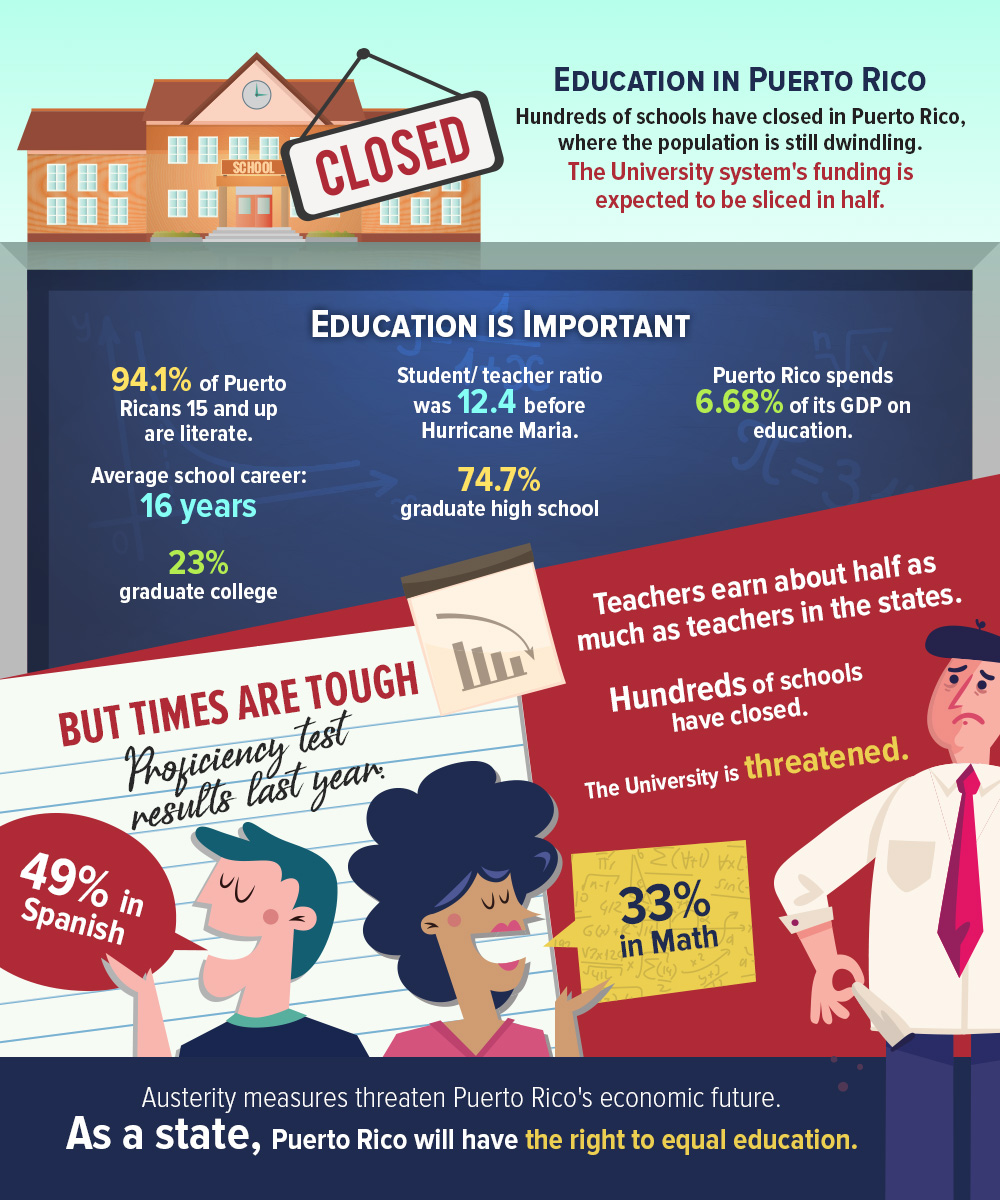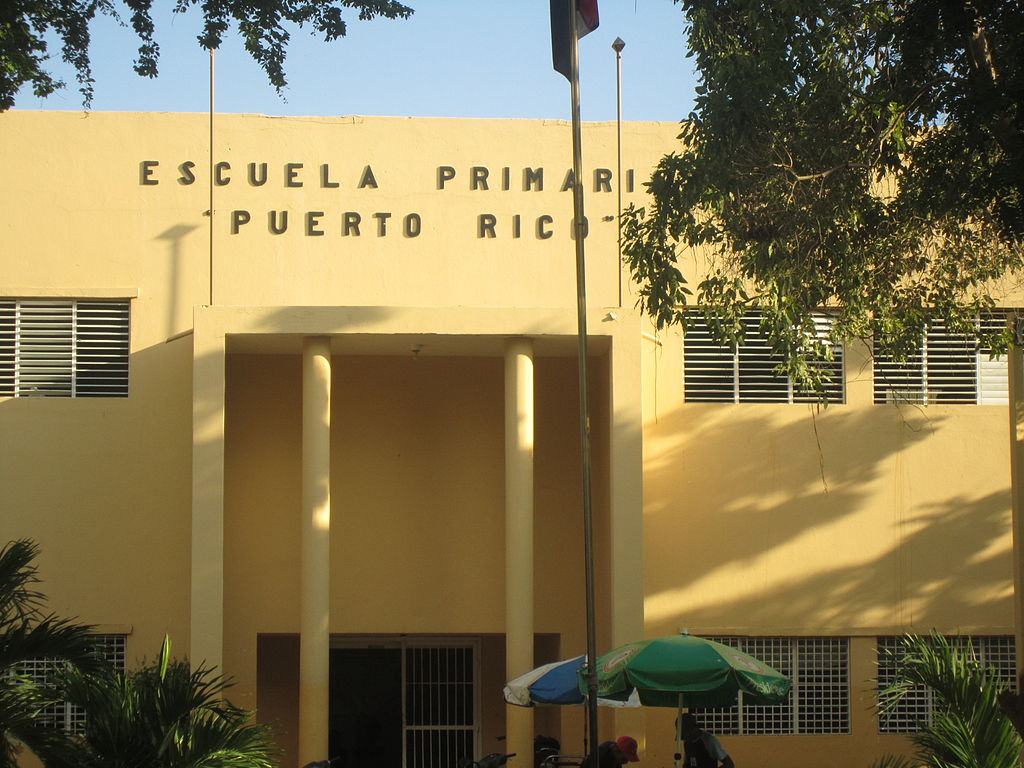Puerto Rico is dealing with many issues right now, but education in Puerto Rico is one of the most important.
When it comes to natural resources, Puerto Rico’s list of resources always includes her people. In a world where remote work is increasingly common, an educated, largely bilingual workforce is a rich resource. When drawing investors from off the Island, that same workforce with its history of manufacturing is one of the most appealing advantages Puerto Rico can show.
The infographic below shows some of the issues Puerto Rico faces in education.

Does federal law guarantee education?
Education is generally a state and local responsibility in the United States. The federal government provides just about 8% of all the funds for K-12 education.
The constitutions of the various states guarantee free public education for all American children. Everyone must have equal access to education, and the same opportunities must be provided for all kids, by federal law. Every state is required to provide a free education to kids living in the state, and to provide equal opportunities for all the kids in the state, on the basis of Supreme Court decisions.
However, this is not part of the U.S. Constitution. There is no fundamental right to education at the federal level. The 10th amendment to the Constitution says that anything not mentioned in the nation’s constitution is left under the control of the states. Education is one of these things.
Puerto Rico’s constitution also lays out the right of children to a free education.
Section 5. Every person has the right to an education which shall be directed to the full development of the human personality and to the strengthening of respect for human rights and fundamental freedoms. There shall be a system of free and wholly non-sectarian public education. Instruction in the elementary and secondary schools shall be free and shall be compulsory in the elementary schools to the extent permitted by the facilities of the state. No public property or public funds shall be used for the support of schools or educational institutions other than those of the state. Nothing contained in this provision shall prevent the state from furnishing.to any child non-educational services established by law for the protection or welfare of children.*
* By Resolution number 34, approved by the Constitutional Convention and ratified in the Referendum held on November 4, 1952, section 5 of article II was amended, adding to such section the following declaration: “Compulsory attendance at elementary public schools to the extent permitted by the facilities of the state as herein provided shall not be construed as applicable to those who receive elementary education in schools established under non-governmental auspices.
Where does the federal government come in?
Federal funds for education are not passed out evenly among the states and territories. States and individual schools get federal funding when they meet certain requirements. There are grants and special funds for special purposes, and each state receives a different kind and amount of funding from the others.
Puerto Rico’s federal funding for education has increased under the current administration, thank to the American Rescue Plan.
In 2022, Puerto Rico received $2.62 billion in federal funds for K-12 education. Utah, a state with a similar population size, received just $456,956,000. However, most funds for public education come from states and cities. Connecticut spends an average of $19,322 per pupil, while Puerto Rico spends $4,319.
Puerto Rico faces some serious challenges. The disruption of Hurricane Maria is an issue. The closing of hundreds of schools in the wake of falling enrollments, increases in psychological needs among students suffering traumatic experiences, and very high absentee rates all affect the effectiveness of the schools.
Teachers in Puerto Rico are paid about half what teachers make in the states. Proficiency levels are low. The budget for higher education has been slashed with record-breaking cuts.
This is a case in which the amount of funds received doesn’t tell the whole story.
How would statehood change education in Puerto Rico?
The federal government has stepped in when states have failed to provide equal educational opportunities for the children living there. They have also stepped in when states have not allocated enough money to provide the kids in their states with a decent education. The Department of Education supports schools with many programs, grants, and training opportunities.
The Office for Civil Rights also works toward equality in schools in all the states. This is not a reality or a right, but it is a goal. “The Office for Civil Rights’ mission is to ensure equal access to education and promote educational excellence throughout the nation through the vigorous enforcement of civil rights.”
With support in Congress, education in a state of Puerto Rico would probably get more attention than Puerto Rico gets as a territory.
However, the amount spent per student in each state varies a lot. Amounts vary within states, too. Broadly speaking, the amount spent correlates with how prosperous a school district is. Every territory which has become a state has become more prosperous as a state. Better funding for education would probably follow. Solutions for the special challenges faced by Puerto Rico in education would also be more likely.








2 Responses
21st century began on
Monday, January 1, 2001
and ends on
Friday, December 31, 2100
21st century students: (define as per Think Strategic)
* Generation Z – born between 1995 and 2009 – most do not remember life without the internet, and have had technology like smartphones, iPads, smartboards and other devices available throughout most of their schooling.
* Generation Alpha – born since 2010 – they are younger than smartphones, the iPad, 3D television, Instagram, and music streaming apps like Spotify. This is the first generation likely to see in the 22nd century in large numbers
World rankings of K-12 education and the best world colleges and universities change on an annual basis. Overall, they offer objective reports through which to learn, draw from, and develop exemplary competitive students and leaders and help ensure the country’s socio-economic future.
Puerto Rico’s K–12th Education System:
What is Puerto Rico’s public educational system’s ranking in the USA and globally?
What explains students’ suboptimal standardized test scores in all subjects?
What is the public school student-teacher ration?
How is a teacher’s current and past knowledge evaluated and certified?
What do the local schools’ infrastructure resources look like and how are they maintained?
What can be done to optimize PR’s department of education bureaucracy and ensure educational state and federal funds are used wisely and not end up in the hands of worthless contracts?
What is the actual K–12th curriculum? How is it reviewed?
Is the current curriculum up to date, keeping up with basic learning and leadership skills in all subjects required to excel in a technologically advanced world in the twenty-first century? How are we preparing for the 22nd century?
Why is the K–12th education system main curriculum still in Spanish, depriving students of becoming proficient in the English language? Most, if not all, successful world-wide educational systems understand that English is the universal language that will give their students top-notch college and employment opportunities.
How many public schools has the Secretary of Education and his board visited?
Have they held teachers’ forums to hear their comments, concerns, or suggestions? Have they met with the municipal leaders to explore joint options and goals to optimize education in each particular district?
How long will it take for the politicians and the multiple private sectors to understand that public and NOT private education in Puerto Rico is key to Puerto Rico’s socio-economic future competitiveness and success?
When will Puerto Rico’s leaders have the courage to confront themselves and move beyond banal, superficial, and artificial values to truly invest in the future of Puerto Rico through its public educational system?
inadvertently omitted:
Have they held student parent forums to hear their comments, concerns, or suggestions?